My Safe PC 2014
Posted: August 19, 2013
Threat Metric
The following fields listed on the Threat Meter containing a specific value, are explained in detail below:
Threat Level: The threat level scale goes from 1 to 10 where 10 is the highest level of severity and 1 is the lowest level of severity. Each specific level is relative to the threat's consistent assessed behaviors collected from SpyHunter's risk assessment model.
Detection Count: The collective number of confirmed and suspected cases of a particular malware threat. The detection count is calculated from infected PCs retrieved from diagnostic and scan log reports generated by SpyHunter.
Volume Count: Similar to the detection count, the Volume Count is specifically based on the number of confirmed and suspected threats infecting systems on a daily basis. High volume counts usually represent a popular threat but may or may not have infected a large number of systems. High detection count threats could lay dormant and have a low volume count. Criteria for Volume Count is relative to a daily detection count.
Trend Path: The Trend Path, utilizing an up arrow, down arrow or equal symbol, represents the level of recent movement of a particular threat. Up arrows represent an increase, down arrows represent a decline and the equal symbol represent no change to a threat's recent movement.
% Impact (Last 7 Days): This demonstrates a 7-day period change in the frequency of a malware threat infecting PCs. The percentage impact correlates directly to the current Trend Path to determine a rise or decline in the percentage.
| Threat Level: | 10/10 |
|---|---|
| Infected PCs: | 68 |
| First Seen: | August 19, 2013 |
|---|---|
| OS(es) Affected: | Windows |
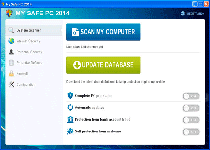 My Safe PC 2014 is a rogue anti-malware program based on the FakeRean family template and includes various security-harming attacks such as blocking other programs, hijacking your browser and displaying fraudulent malware warnings. Alerts from My Safe PC 2014 infections will attempt to convince their victims that their PCs are being attacked by numerous PC threats, including keyloggers and other forms of spyware, but My Safe PC 2014 can neither detect nor delete real malware. The typical reaction to My Safe PC 2014 always should be to use a real anti-malware product to remove My Safe PC 2014 immediately, although SpywareRemove.com malware researchers usually find that some additional security steps are required to gain unimpeded access to all necessary software.
My Safe PC 2014 is a rogue anti-malware program based on the FakeRean family template and includes various security-harming attacks such as blocking other programs, hijacking your browser and displaying fraudulent malware warnings. Alerts from My Safe PC 2014 infections will attempt to convince their victims that their PCs are being attacked by numerous PC threats, including keyloggers and other forms of spyware, but My Safe PC 2014 can neither detect nor delete real malware. The typical reaction to My Safe PC 2014 always should be to use a real anti-malware product to remove My Safe PC 2014 immediately, although SpywareRemove.com malware researchers usually find that some additional security steps are required to gain unimpeded access to all necessary software.
My Safe PC 2014: Ironically Making Your PC as Unsafe as Possible
My Safe PC 2014 is disguised to look identical to a real anti-malware product, but actually is scamware that can only attack your PC, rather than protect it. The majority of My Safe PC 2014's appearance and attacks are culled from previous members of its family (identified by SpywareRemove.com malware experts as FakeRean). My Safe PC 2014's family has numerous branches with minor divergences in behavior, including individual variants like Antivirus 2008 Pro, Windows Antivirus 2008, Vista Antivirus 2008, Antivirus XP 2008, PC Clean Pro, Antivirus Pro 2009, AntiSpy Safeguard, ThinkPoint, Spyware Protection 2010, Internet Antivirus 2011, Palladium Pro, XP Anti-Virus 2011, CleanThis, Rogue.Vista Antivirus 2008, XP Home Security 2012, XP Security 2012 and AntiVirus PRO 2015. Symptoms that one may expect from My Safe PC 2014 or most related rogue anti-malware programs include:
- My Safe PC 2014 will reroute any attempts to use executable (EXE) program files towards itself. In most cases, My Safe PC 2014 will block the affected program and generate a fraudulent pop-up claiming that the program has been infected. Some basic Windows programs, including your browser, will remain unblocked.
- If you attempt to use your browser to navigate to a security-related site (such as Microsoft.com), My Safe PC 2014 will hijack your browser and redirect it to a fraudulent warning page.
- In a less visible (but no less dangerous) attack than the above, My Safe PC 2014 also will make various changes to your browser that harm your PC's security. Typical changes may include blocking the Windows update cycle or deactivating your default firewall.
- In accordance with its disguise as an anti-malware product, My Safe PC 2014 also will display pop-ups and system scans that are pre-configured to always 'detect' PC threats on your computer even if My Safe PC 2014 is the only malware present. These deliberately misleading attacks are intended to frighten you into spending money on My Safe PC 2014's fraudulent software registration, which supposedly will disinfect your computer.
Getting Real Safety from My Safe PC 2014
Ordinarily, PCs that are infected with My Safe PC 2014 are compromised by secondary Trojans or by online exploit kits like Blackhole Exploit Kit that also may install additional PC threats besides My Safe PC 2014. Due to this inherent risk, SpywareRemove.com malware experts recommend using anti-malware software to scan your computer generously for clearing up any My Safe PC 2014 infection, which should allow you to identify any other malware related to its presence.
Because My Safe PC 2014 usually will block anti-malware programs on sight, you may need to disable My Safe PC 2014 before using all necessary security software. However, booting from a secure peripheral device can allow you to launch Windows without My Safe PC 2014 and related PC threats also being launched. SpywareRemove.com malware experts also recommend using Safe Mode as the preferred anti-malware scanning environment whenever possible.
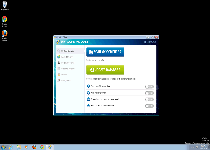
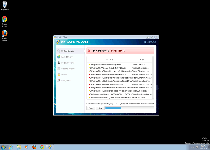
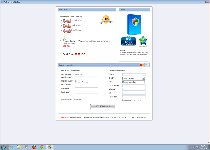
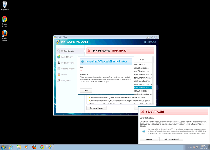
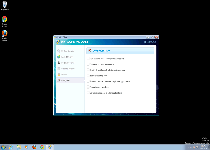
Aliases
More aliases (32)
Use SpyHunter to Detect and Remove PC Threats
If you are concerned that malware or PC threats similar to My Safe PC 2014 may have infected your computer, we recommend you start an in-depth system scan with SpyHunter. SpyHunter is an advanced malware protection and remediation application that offers subscribers a comprehensive method for protecting PCs from malware, in addition to providing one-on-one technical support service.
* See Free Trial offer below. EULA and Privacy/Cookie Policy.
Why can't I open any program including SpyHunter? You may have a malware file running in memory that kills any programs that you try to launch on your PC. Tip: Download SpyHunter from a clean computer, copy it to a USB thumb drive, DVD or CD, then install it on the infected PC and run SpyHunter's malware scanner.
Technical Details
File System Modifications
Tutorials: If you wish to learn how to remove malware components manually, you can read the tutorials on how to find malware, kill unwanted processes, remove malicious DLLs and delete other harmful files. Always be sure to back up your PC before making any changes.
The following files were created in the system:GRPCONV.EXE
File name: GRPCONV.EXESize: 62.32 KB (62328 bytes)
MD5: 4548ee82b890bbbc3af1a8c66f7848a6
Detection count: 13
File type: Executable File
Mime Type: unknown/EXE
Group: Malware file
Last Updated: August 19, 2013
%Desktop%\My Safe PC 2014.lnk
File name: %Desktop%\My Safe PC 2014.lnkFile type: Shortcut
Mime Type: unknown/lnk
Group: Malware file
%CommonAppData%\pavsdata\
File name: %CommonAppData%\pavsdata\Group: Malware file
%CommonAppData%\pavsdata\app.ico
File name: %CommonAppData%\pavsdata\app.icoMime Type: unknown/ico
Group: Malware file
%CommonAppData%\pavsdata\uninst.ico
File name: %CommonAppData%\pavsdata\uninst.icoMime Type: unknown/ico
Group: Malware file
%CommonAppData%\pavsdata\support.ico
File name: %CommonAppData%\pavsdata\support.icoMime Type: unknown/ico
Group: Malware file
%CommonAppData%\pavsdata\idfdata.bin
File name: %CommonAppData%\pavsdata\idfdata.binFile type: Binary File
Mime Type: unknown/bin
Group: Malware file
%CommonAppData%\pavsdata\cache.bin
File name: %CommonAppData%\pavsdata\cache.binFile type: Binary File
Mime Type: unknown/bin
Group: Malware file
%CommonAppData%\pavsdata\security_defender.exe
File name: %CommonAppData%\pavsdata\security_defender.exeFile type: Executable File
Mime Type: unknown/exe
Group: Malware file
%CommonStartMenu%\Programs\My Safe PC 2014\
File name: %CommonStartMenu%\Programs\My Safe PC 2014\Group: Malware file
%CommonStartMenu%\Programs\My Safe PC 2014\My Safe PC 2014.lnk
File name: %CommonStartMenu%\Programs\My Safe PC 2014\My Safe PC 2014.lnkFile type: Shortcut
Mime Type: unknown/lnk
Group: Malware file
%CommonStartMenu%\Programs\My Safe PC 2014\Remove My Safe PC 2014.lnk
File name: %CommonStartMenu%\Programs\My Safe PC 2014\Remove My Safe PC 2014.lnkFile type: Shortcut
Mime Type: unknown/lnk
Group: Malware file
%CommonStartMenu%\Programs\My Safe PC 2014\My Safe PC 2014 Help and Support.lnk
File name: %CommonStartMenu%\Programs\My Safe PC 2014\My Safe PC 2014 Help and Support.lnkFile type: Shortcut
Mime Type: unknown/lnk
Group: Malware file
Registry Modifications
HKEY..\..\{Value}HKEY_CURRENT_USER\Software\Classes\.exe "(Default)" = "4g"HKEY_CURRENT_USER\Software\Microsoft\Windows\CurrentVersion\Run "avsdsvc" = "%CommonAppData%\pavsdata\security_defender.exe /min"HKEY_CURRENT_USER\Software\Classes\.exe\shell\open\command "(Default)" = ""%CommonAppData%\pavsdata\security_defender.exe" /ex "%1" %*"HKEY..\..\..\..{Subkeys}HKEY_LOCAL_MACHINE\SOFTWARE\Microsoft\Windows\CurrentVersion\Uninstall\pavsdata
Additional Information
| # | Message |
|---|---|
| 1 | My Safe PC 2014 Firewall Alert notepad.exe is infected with Trojan-GameThief.Win32.Nilage.ipj Private data can be stolen by third parties, including credit card details and passwords. |
| 2 | Security Alert Vulnerabilities Found Background scan for security breaches has been finished. Serious problems have been detected. Safeguard your system against exploits, malware and viruses right now by activating Proactive Defence. Upgrade to full version of My Safe PC 2014 software package now! Clean your system and ward off new attacks against your system integrity and sensitive data. FREE daily updates and online protection from web-based intrusions are already in the bundle. |
| 3 | System Security Alert Unknown program is scanning your system registry right now! Identity theft detected. |
| 4 | System Security Alert Vulnerabilities found Background scan for security breaches was finished. Serious issues were detected. Safeguard your system against exploits, malware and viruses right now by activating Proactive Defense. |
Leave a Reply
Please note that we are not able to assist with billing and support issues regarding SpyHunter or other products. If you're having issues with SpyHunter, please get in touch with SpyHunter customer support through your SpyHunter . If you have SpyHunter billing questions, we recommend you check the Billing FAQ. For general suggestions or feedback, contact us.